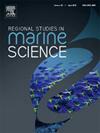Inter-annual variability in the phytoplankton abundance and community structure of a tropical monsoonal estuary in response to variable monsoonal patterns
IF 2.1
4区 环境科学与生态学
Q3 ECOLOGY
引用次数: 0
Abstract
The study elucidates the inter-annual and seasonal variability in the phytoplankton abundance and community structure concurrent to variable rainfall patterns in Chettuva, a tropical monsoonal estuary along the southwest coast of India. The phytoplankton community exhibited statistically significant inter-annual variation with a 1.2-fold increase in abundance (av. 19.44 ×104cellsL−1) in 2021 in comparison with 2019 (av. 15.30 ×104cellsL−1). A total of 87 phytoplankton species were observed during the study, among which Bacillariophyceae dominated with 52 species, followed by Dinophyceae (20 species), and to a lesser extent by Chlorophyceae (11 species) and Cyanophyceae (2 species). Phytoplankton community structure also showed variation, with 71 species contributing to the diversity in 2021 and 62 species in 2019. Though Bacillariophycea dominated during both years, the community was more diverse in 2021comparatively a more saline year Biddulphia sp. Coscinodiscus sp., Cyclotella striata, Melosira sulcata, Pleurosigma sp., and Skeletonema costatum were the diatoms common to both the years, though with varied abundance. Dinophyceae did not show a conspicuous change in community structure in both years, with mostly the same species contributing to the total phytoplankton population but showed slight variation in abundance. Cyanophycea was observed exclusively during the year 2021. The abundance and community structure of the species varied from year to year, but they also changed seasonally, with lower numbers observed during the monsoon compared to the post-monsoon period in both years. CCA analysis identified two groups of phytoplankton assemblages in relation to the prevailing environmental conditions. The Group I species preferred lower temperature and salinity and elevated nutrient concentrations and they dominated during the monsoon season. Group II species preferred high saline well oxygenated, nutrient-poor waters and they dominated during the post-monsoon. Furthermore, the trophic state index analysis indicated mesotrophic conditions during the monsoon, while eutrophic conditions were observed in the post-monsoon period.
热带季风河口浮游植物丰度和群落结构随季风模式变化而出现的年际变化
该研究阐明了印度西南海岸热带季风河口 Chettuva 浮游植物丰度和群落结构随降雨模式变化而产生的年际和季节变化。据统计,浮游植物群落呈现出显著的年际变化,2021 年的丰度(平均 19.44 ×104cellsL-1 )比 2019 年(平均 15.30 ×104cellsL-1 )增加了 1.2 倍。研究期间共观察到 87 种浮游植物,其中以芽孢杆菌科(52 种)为主,其次是叶绿藻科(20 种),再次是叶绿藻科(11 种)和蓝藻科(2 种)。浮游植物群落结构也有变化,2021 年有 71 个物种,2019 年有 62 个物种。虽然 Bacillariophycea 在这两年都占主导地位,但 2021 年的群落更加多样化,因为 2021 年盐度较高,Biddulphia sp. Coscinodiscus sp.、Cyclotella striata、Melosira sulcata、Pleurosigma sp.和 Skeletonema costatum 是这两年常见的硅藻,但丰度各不相同。在这两年中,叶绿藻群落结构没有明显变化,浮游植物总数量中大部分为相同种类,但丰度略有不同。2021 年只观察到蓝藻。各物种的丰度和群落结构每年都有变化,但也有季节性变化,在这两年中,季风期观察到的物种数量都低于季风后时期。根据当时的环境条件,CCA 分析确定了两组浮游植物群落。第 I 组物种喜欢较低的温度和盐度以及较高的营养浓度,在季风季节占主导地位。第 II 组物种喜欢高盐度、高含氧、低营养的水域,它们在季风后占主导地位。此外,营养状态指数分析表明,季风期间为中营养状态,而季风过后为富营养状态。
本文章由计算机程序翻译,如有差异,请以英文原文为准。
求助全文
约1分钟内获得全文
求助全文
来源期刊

Regional Studies in Marine Science
Agricultural and Biological Sciences-Ecology, Evolution, Behavior and Systematics
CiteScore
3.90
自引率
4.80%
发文量
336
审稿时长
69 days
期刊介绍:
REGIONAL STUDIES IN MARINE SCIENCE will publish scientifically sound papers on regional aspects of maritime and marine resources in estuaries, coastal zones, continental shelf, the seas and oceans.
 求助内容:
求助内容: 应助结果提醒方式:
应助结果提醒方式:


